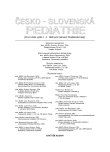-
Medical journals
- Career
Program of Hematopoietic Stem Cell Transplantation in Children at Department of Pediatric Hematology and Oncology, University Hospital Motol – from Fetal Liver to Cord Blood
Authors: P. Sedláček 1; R. Formánková 1; P. Keslová 1; E. Mejstříková 1; P. Kobylka 2; A. Hrubá 2; I. Fales 2; Š. Rahmatová 2; Z. Sieglová 2; P. Hubáček 1; V. Vávra 1; L. Šrámková 1; V. Komrska 1; J. Trka 1; J. Starý 1
Authors‘ workplace: Klinika dětské hematologie a onkologie UK 2. LF, FN Motol, Praha přednosta prof. MUDr. J. Starý, DrSc. 1; Ústav hematologie a krevní transfuze, Praha přednosta prof. MUDr. P. Klener, DrSc. 2
Published in: Čes-slov Pediat 2007; 62 (9): 510-518.
Category: Original Papers
Overview
Objectives:
Transplantation of allogeneic stem cells from healthy donor can cure several malignant and non-malignant disorders in children. In this paper authors evaluate results of allogeneic SCT (stem cell transplantation) in children performed at transplant center from November, 1989, to December, 2005. At certain time points they determine survival rates, death rates due to toxicity or relapse of malignancy, changes in donors and grafts composition.Patients and methods:
From 1989 till 2005 altogether 265 patients at the age of 0.2–20.5 years (median 9.7) underwent first allogeneic SCT at transplant unit (Teaching Hospital Motol, Prague). 71% (n=189) were transplanted for malignant disease (acute leukemia, myelodysplastic syndrome, chronic myelogenous leukemia, lymphoma, etc.), other for life-threatening non-malignant disorder (congenital or acquired bone marrow failure, severe immunodeficiency, osteopetrosis, mucopolysaccharidosis type I., adrenoleukodystrophy, etc.). At the beginning matched sibling donors were predominantly used (81%). Bone marrow was used as a source of stem cells in majority of patients (93%). Over last period authors use more frequently graft obtained from unrelated donor (68%), bone marrow is currently used in only 58% of transplants.Results:
Out of 265 transplanted patients 165 (62%) survive. The survival is higher in the group of children transplanted for non-malignant disorder (80% versus 55%). Over the time the authors successfully reduced overall transplant related mortality from 29% to 9%. Survival rate improved markedly from 46% (1989–2000) to 80% (2001–2005).Conclusions:
Allogeneic SCT at the transplant unit over the passed years became a standard procedure in the therapy of advanced stages of malignant diseases or some life-threatening non-malignant disorders for children from all the Czech Republic. For such children transplantation represents the last chance to be cured. Even with majority of transplants being done using grafts from alternative donors, the authors achieve the same excellent results as they do in outstanding European pediatric transplant centers.Key words:
pediatrics, allogeneic transplantation, hematopoietic stem cell, fetal liver, cord blood, alternative donors
Labels
Neonatology Paediatrics General practitioner for children and adolescents
Article was published inCzech-Slovak Pediatrics

2007 Issue 9-
All articles in this issue
- The Problems of Inhibitor in Children Hemophilic Patients Observed at the Pediatric Hematology and Oncology Clinic, University Hospital Prague-Motol
- Program of Hematopoietic Stem Cell Transplantation in Children at Department of Pediatric Hematology and Oncology, University Hospital Motol – from Fetal Liver to Cord Blood
- Unstable Hemoglobin Variants in Children of the Czech and Slovak Population
- Infection with Bacteria Pseudomonas aeruginosa in Patients with Cystic Fibrosis Diagnostics Possibilities and Clinical Outcomes of a Three-Year Study
- Body Height and Body Mass Index in Patients with MODY2 Diabetes (Glucokinase Defect) in Childhood and Adulthood – a Pilot Study
- Fifty Years of Successful Treatment of Childhood Acute Lymphoblastic Leukemi
- Disorders of Hemostasis in Newborns
- Czech-Slovak Pediatrics
- Journal archive
- Current issue
- Online only
- About the journal
Most read in this issue- Infection with Bacteria Pseudomonas aeruginosa in Patients with Cystic Fibrosis Diagnostics Possibilities and Clinical Outcomes of a Three-Year Study
- Disorders of Hemostasis in Newborns
- Unstable Hemoglobin Variants in Children of the Czech and Slovak Population
- The Problems of Inhibitor in Children Hemophilic Patients Observed at the Pediatric Hematology and Oncology Clinic, University Hospital Prague-Motol
Login#ADS_BOTTOM_SCRIPTS#Forgotten passwordEnter the email address that you registered with. We will send you instructions on how to set a new password.
- Career

